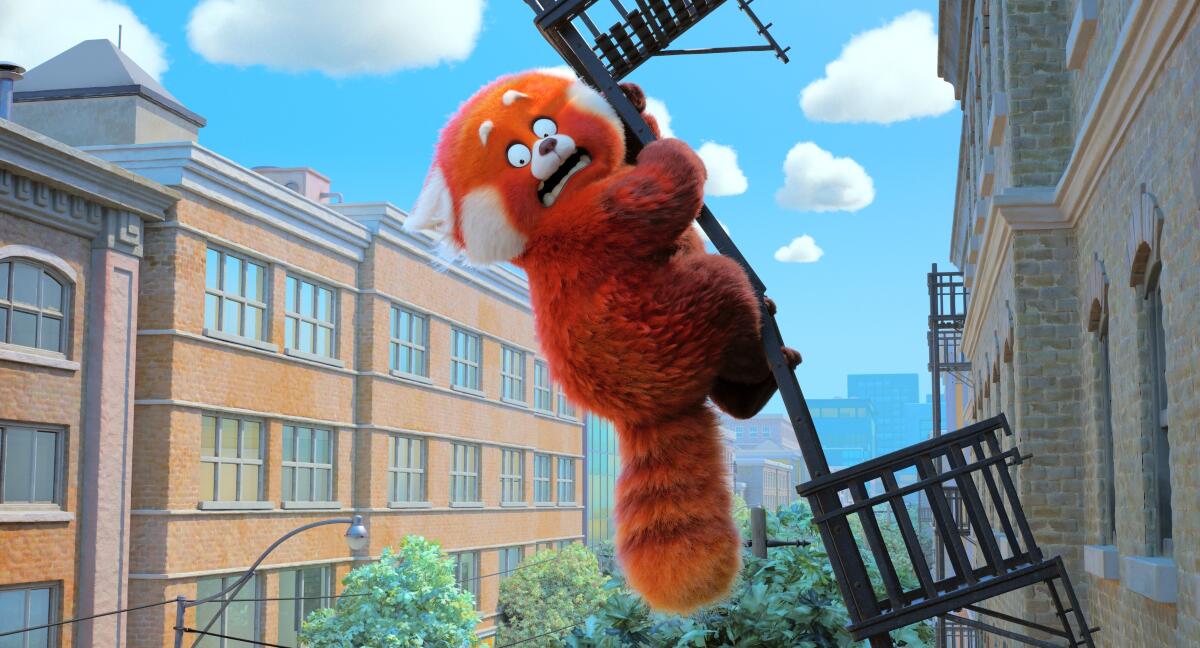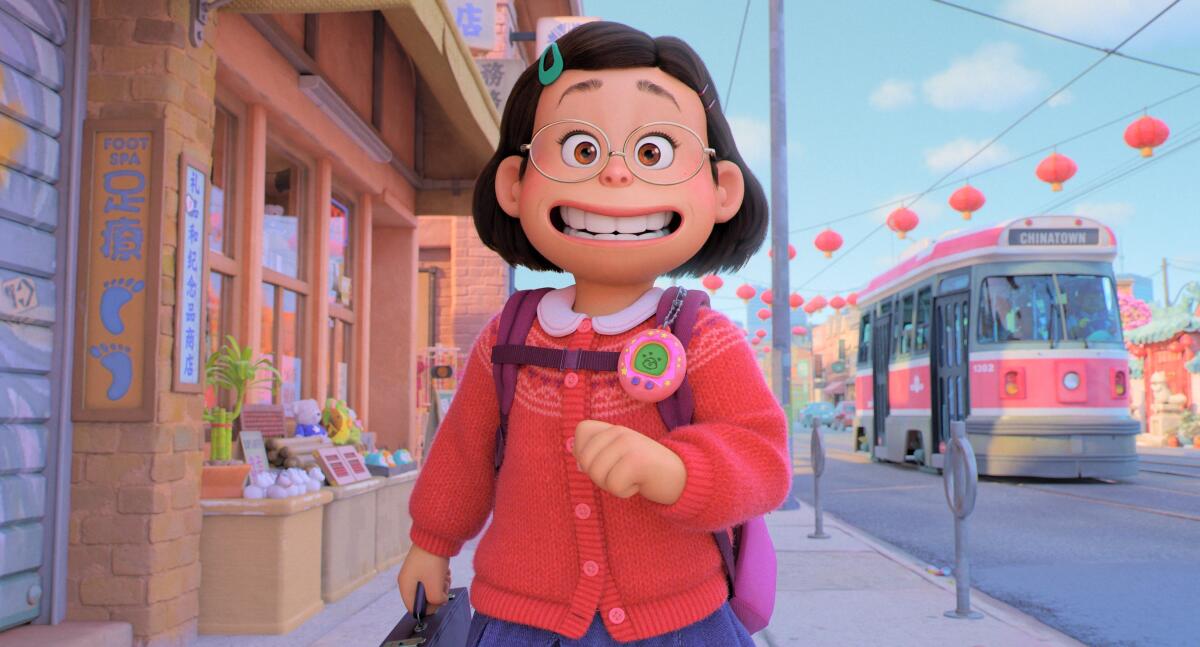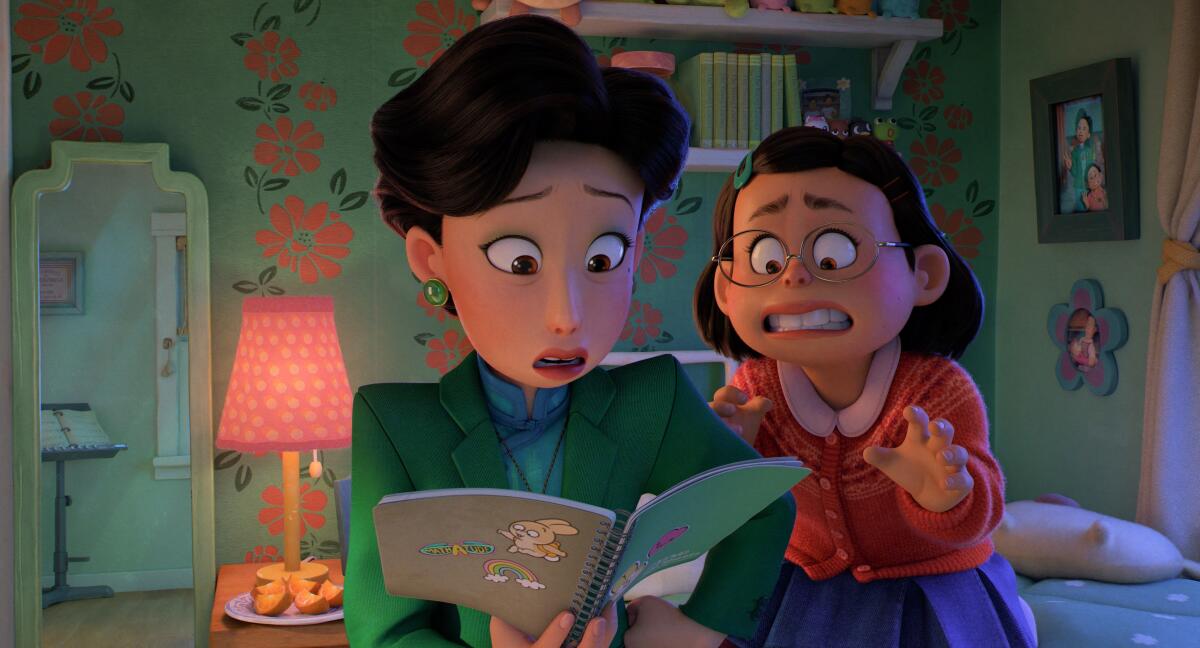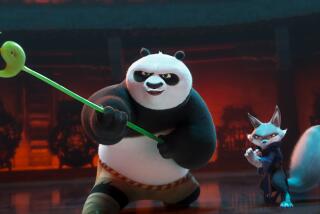Review: With the charming ‘Turning Red,’ Pixar unleashes teenage panda-monium

As 13-year-old Meilin Lee awakes one morning from uneasy dreams, she finds herself transformed in her bed into an enormous red panda — a cuddly giant ball of scarlet fluff with pointy white ears and a long, bushy tail. That tail will cause a bit of damage; so will Mei’s efforts to hide the truth about the big, smelly, unruly monster she’s become overnight. Chaos reigns, to quote a similarly red-furred critter from “Antichrist,” a rather less family-friendly movie about female sexuality and its discontents. Mei’s panda persona may be an adorably oversized plush toy (and the latest merchandising boon to the Walt Disney Co.), but she’s also one hell of a menstrual metaphor.
Which is not to say that “Turning Red” — a cheeky title for a movie that sometimes plays like “Carrie” with the cutes, or “The Joy Luck Club” meets “Ginger Snaps” — deals purely in the metaphorical. After decades of Disney animated entertainments that thrive on the emotions (but not the effluvia) of young womanhood, this charming comic fantasy — arriving this week on Disney+ but not, regrettably, in theaters — marks something of a messy pubescent milestone. It’s surely the first movie of its kind to introduce sanitary pads as a plot device, which is scarcely the least of its many key precedents. It also happens to be the first to boast a Chinese Canadian girl protagonist who keeps a Tamagotchi (it’s set in the early 2000s), fawns over a boy band and still manages to get straight A’s. (Mei twerks hard, but she works harder.) And perhaps not coincidentally, it’s the first Pixar feature directed solely by a woman: Domee Shi, here confidently expanding on the images and ideas of her scrumptious 2018 Oscar-winning short, “Bao.”
That gender precedent is more depressing than laudable, and in appreciating the taboo-busting, culturally inclusive virtues of “Turning Red,” we should be cautious about overpraising a corporate giant that’s always been quicker to congratulate itself than to evolve. Still, as Mei (delightfully voiced by Rosalie Chiang) rightly enthuses, “Nothing stays the same forever” — not hidebound movie studios, and certainly not teen girls. When we first meet Mei, an eighth-grader with round glasses and a garlic-bulb nose, she’s already on the cusp of major change. For 13 years she’s been the picture of filial obedience, an eager-to-please overachiever who helps her parents run their ancestral temple in Toronto’s Chinatown. But her perfect-daughter devotion is increasingly at odds with other interests: her pop culture enthusiasms, intense crushes and supercool friends. (Her terrific trio of besties is voiced by Ava Morse, Maitreyi Ramakrishnan and Hyein Park.)

And so when Mei awakens and finds herself panda-fied for the first time, she’s unsurprisingly mortified at this bizarre outward manifestation of her inner unrest. Part of the charm of “Turning Red” is the way it initially refuses to explain what’s happening to Mei, trusting the potency of its hormonal subtext and our ease with the whimsical story logic of the Pixar universe. Just as the color red has many associations, so the panda functions, ingeniously, as both a symbol of adolescent awkwardness and a relic of the family’s Chinese heritage. Mei becomes a panda whenever she feels intense emotion, and can ward off the transformation by staying calm. Repress, repress, repress, in other words — a lesson that’s already been drilled into her for years by her overbearing mother, Ming (a terrific and unmistakable Sandra Oh), and, by extension, her sensitive, stay-out-of-the-way father (Orion Lee).
Not that Ming would describe her behavior — her strict policing of her daughter’s academics and social life, her belief that everyone and everything outside their home is a contaminating influence — as overbearing. Shi and her co-writer, Julia Cho, play deftly if sometimes exaggeratedly with the figure of the Asian tiger mom, pushing Ming to an outlandish comic extreme early on when she publicly humiliates Mei after a misunderstanding. You might scoff or wince at that moment (I did a little of both), which occupies that perplexing zone where truth and stereotype meet. But you might also appreciate the cultural dimension that makes Mei’s mortification so personal. Helicopter parents and rebellious kids clash every day, but it’s specifically Ming’s Chinese-ness, her perceived outsider status, that gives her “psycho mom” reputation such a sharp sting.
And so while “Turning Red” has the fanciful, farcical complications you might recognize from other Pixar movies — supernatural twists, clever coincidences — its busy narrative machinery is driven by the inordinate pressure Mei feels to keep her worlds separate. Here, the horrors of bodily transformation and the challenges of cultural assimilation become one and the same. At school, Mei soon realizes that her friends, far from being weirded out by her panda avatar, might in fact consider it, like, the coolest thing ever. At home, the big red monster must be suppressed, along with her goofy personality and raging libido.
That of course means downplaying her obsession with 4*Town, a boy band whose pelvic gyrations and confusingly punctuated moniker are clearly modeled on ’N Sync (N*Sync? *NSYNC?) at the peak of its early-aughties popularity. It’s probably not revealing too much to note that a badly timed 4*Town concert will factor heavily into the plot, or that the band’s songs are velvety earworms of the highest order. (Billie Eilish and Finneas wrote the songs; Ludwig Göransson composed the movie’s score.) There’s something particularly pleasing about the harmony that “Turning Red” achieves between the lyricism of ancient Chinese legend and the synthetic creaminess of teeny-bopper pop.

But then, the conscious merging of Eastern and Western traditions is hardly incidental to Shi’s project. The influence of Hayao Miyazaki, a touchstone for more than a few Pixar artists, can be discerned in everything from the Totoro-esque dimensions of Mei’s panda to the oval shape of her toothy human grin. In an era that predates Snapchat, the blissful scenes of Mei hanging with her girlfriends recall the rainbow-and-glitter aesthetics of purikura photo booths. (One of those friends, Abby, recalls a cruder era of anime character design.) The climactic action scenes owe something to classic kaiju movies; the more lyrical moments — a dreamlike interlude in a bamboo forest, a scene of Mei’s panda leaping over the moonlit rooftops of Toronto — are pure wuxia epic.
All these flavorsome cultural underpinnings have been marshaled in service of familiar Disney/Pixar themes: the importance of finding your own way through the world, of learning to embrace emotion and relinquish control. The ending could be a rejoinder to — or a confirmation of — that passage from Amy Chua’s “Battle Hymn of the Tiger Mother” in which she specifically derided the Disney-movie tradition where “the ‘good’ daughter always has to have a breakdown and realize that life is not all about following rules and winning prizes.” Those same Disney movies are of course teeming with bad moms (or at least stepmoms), a trope that “Turning Red” slyly turns on its head. In seeing both the villainy and the vulnerability in Ming’s outsize rage, it suggests that mothers and daughters — good, bad and mostly in between — exist on a shared moral, cultural and generational continuum.
There’s a lot to argue about there. There’s also the usual built-in Pixar contradiction, namely that a company that routinely encourages us to abandon the pursuit of perfectionism continues to be run by some of the proudest control freaks in the business. I mean that mostly as a compliment, though not an unqualified one. “Turning Red” is a delight and, I suspect, an endlessly replayable one, though in its eagerness to clean up its own impressively messy emotions in the final stretch, it falls short of the catharsis it’s aiming for. Let’s score it a solid B-plus. Most would consider that a rave, even if Mei’s mom — and mine — would beg to differ.
‘Turning Red’
Rated: PG, for thematic material, suggestive content and language
Running time: 1 hour, 40 minutes
Playing: Streaming March 11 on Disney+
More to Read
Only good movies
Get the Indie Focus newsletter, Mark Olsen's weekly guide to the world of cinema.
You may occasionally receive promotional content from the Los Angeles Times.











